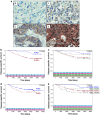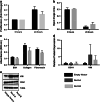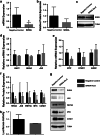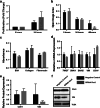Expression of the novel Wnt receptor ROR2 is increased in breast cancer and may regulate both β-catenin dependent and independent Wnt signalling
- PMID: 25209439
- PMCID: PMC11824089
- DOI: 10.1007/s00432-014-1824-y
Expression of the novel Wnt receptor ROR2 is increased in breast cancer and may regulate both β-catenin dependent and independent Wnt signalling
Abstract
Purpose: Wnt signalling has been implicated in breast cancer, and in particular aberrant β-catenin-independent Wnt signalling has been associated with breast cancer metastasis and Tamoxifen resistance. Despite Wnt pathway involvement in many human cancers, attempts to target the pathway therapeutically have been disappointing. The recent discovery that the receptor tyrosine kinase-like orphan receptor 2 (ROR2) is a novel Wnt receptor provides a potential new therapeutic and diagnostic target.
Methods: To clarify the role of ROR2 in breast cancer, we investigated its expression via ROR2 immunohistochemistry in a clinical cohort of breast cancer patients, and via in vitro studies incorporating both overexpression and knock-down of ROR2.
Results: ROR2 was expressed in the majority of breast cancer patients (87%), including those classed as triple negative. Breast cancer patients expressing ROR2 had a significantly shorter overall survival than those lacking ROR2 expression (P < 0.05). Overexpression of ROR2 in the mammary epithelial cell line, MCF10A, increased both β-catenin-dependent and β-catenin-independent targets and decreased cell adhesion. Knock-down of ROR2 in the breast cancer cell lines, MDA-MB-453 and HCC1143, decreased both β-catenin-dependent and β-catenin-independent targets and increased cell adhesion. Treatment of ROR2-expressing breast cancer cells with the novel berberine derivative, NAX53, significantly inhibited cell proliferation and migration.
Conclusions: This is the first study to report the expression of ROR2 in breast cancer. Breast cancer patients expressing ROR2 had a significantly worse prognosis than those lacking ROR2. ROR2 may regulate both β-catenin-dependent and β-catenin-independent Wnt signalling pathways, and represents a potential diagnostic and therapeutic target.
Conflict of interest statement
The authors declare that they have no conflict of interests.
Figures






References
-
- Albring KF et al (2013) Berberine acts as a natural inhibitor of Wnt/beta-catenin signaling—identification of more active 13-arylalkyl derivatives. BioFactors 39:652–662. doi:10.1002/biof.1133 - PubMed
-
- Arnaout-Alkarain A, Kahn HJ, Narod SA, Sun PA, Marks AN (2007) Significance of lymph vessel invasion identified by the endothelial lymphatic marker D2-40 in node negative breast cancer. Mod Pathol 20:183–191 - PubMed
-
- Ford CE, Ma Q, Si S, Quadir A, Ward RL (2013) The dual role of the novel Wnt receptor tyrosine kinase, ROR2, in human carcinogenesis. Int J Cancer 133:779–787 - PubMed
-
- Geback T, Schulz MM, Koumoutsakos P, Detmar M (2009) TScratch: a novel and simple software tool for automated analysis of monolayer wound healing assays. Biotechniques 46:265–274. doi:10.2144/000113083 - PubMed
Publication types
MeSH terms
Substances
LinkOut - more resources
Full Text Sources
Other Literature Sources
Miscellaneous

